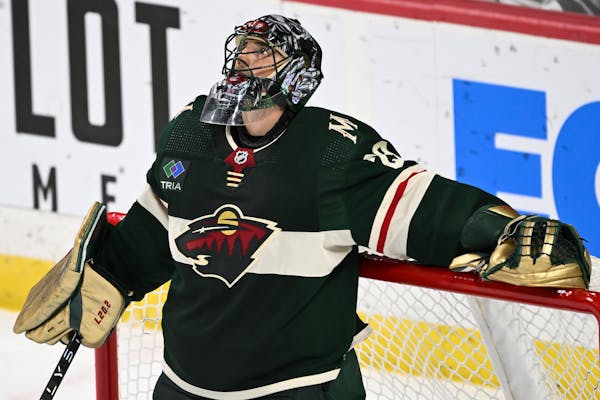If the Wild were looking at Thursday's game against Vegas as a statement of sorts — a chance to evaluate where they stand as the start of a long stretch of home games against quality teams clashed with an ugly stretch of recent play — it did provide that.
Unfortunately, it was a statement of the obvious: The Wild are who they have been all season, a team that struggles to score at even strength and has been propped up by defense and special teams — a complete reversal from last season, and a manner of play that looks particularly ugly when scoring dries up.
After outscoring opponents 207-150 in 5-on-5 play last year, the Wild are being outscored 92-85 this season. They're scoring almost a full goal per game less (2.5 vs. 1.7) while giving up about the same (1.8) at 5-on-5.
I talked about these things on Friday's Daily Delivery podcast.
As the Wild's playoff position becomes far more tenuous, let's take a deeper look at why the season has played out this way, and particularly why 5-on-5 scoring has been so hard to come by this year.
1 Personnel: The shortest and simplest answer is that the Wild's second line isn't as good as it was a year ago, when Kevin Fiala was the anchor scorer and tallied 27 even-strength goals. The pinch of the Zach Parise and Ryan Suter buyouts necessitated tough choices, and one Bill Guerin made was trading Fiala to the Kings. Having fewer dangerous lines also lets opponents focus even more defensive energy on the Kirill Kaprizov top line, which I'll get to in more detail in a moment.
2 Style change: The Wild are intentionally playing a tighter style this year, fueled (my guess) by both an understanding that they aren't as dangerous 5-on-5 and that tweaks such as more emphasis on special teams and less reliance on up-and-down scoring could be a better path to playoff success.
3 Better special teams: In some ways, those changes have worked. The Wild were outscored 65-47 in 5-on-4 situations last year. This year, they are outscoring opponents 43-31 when one team has a one-man advantage (including a hilarious 1-0 edge Thursday despite being outscored 4-0 in 5-on-5 play). With a better power play (and seven short-handed goals), they haven't needed as much even-strength scoring to win games.
4 Regression: That said, I'm sure the Wild would love to score in all situations. But in addition to losing Fiala, they likely understood that some facets of last year's goal-scoring binge were unsustainable. One that has stood out: Ryan Hartman, who had a career year with 34 goals (including 33 at even-strength) last season has just five even-strength goals this year. Hartman, Kaprizov and Mats Zuccarello combined for 83 even-strength goals last season. This year, they have just 32 so far as teams have zeroed in on that line and Hartman — by both his play and injury — has seen his production dramatically tail off. The reuniting of that line recently hasn't sparked offense, but last year's production is a template for hope.
5 Luck: The Wild last season were No. 2 in the NHL in shooting percentage, scoring on 11.4% of their shots. This year, they are down at No. 23 and 9.4%. I like to think of shooting percentage in hockey in the same context as turnover differential in football. It's highly correlated to winning, controllable in some aspects but also volatile because of elements of luck. A fumble bounces one way, a puck deflects off a shin pad, etc. This shows up in another stat: The Wild last year outperformed by 50 goals their "expected goals" at 5-on-5 (207 actual vs. 157 expected), per Natural Stat Trick. This year, they are underperforming by 13 (85 actual vs. 98 expected). In terms of expected goals, they are almost identical 5-on-5 this year and last year: About 1.9 per game. But actual goals are all that really matter, in that area it's plain to see the Wild are coming up short.

